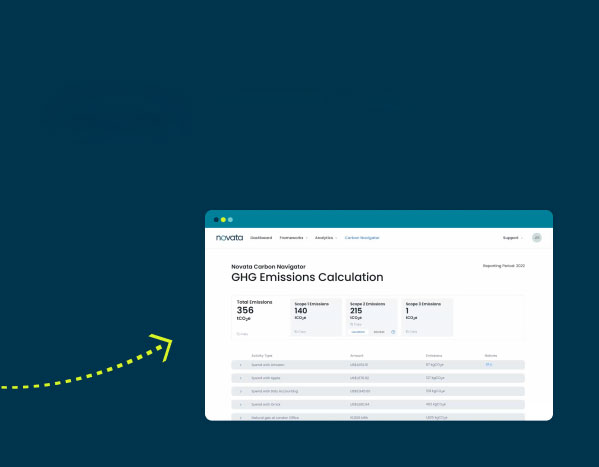There is a rising focus on ESG regulations in the US market, characterized by increasing investor pressures and a growing understanding of the impact of ESG considerations on better financial performance. US investors and asset managers are beginning to pay closer attention to how these mandatory regulations will affect their future operations and opportunities on a global scale.
To help make sense of these complex ESG regulations, Novata recently held a webinar breaking down the regulations that are most pertinent to the US markets. The insightful session was moderated by Beth Meyer, Chief Legal Officer at Novata, and featured Novata’s in-house experts — Teresa Yu, ESG Metrics & Regulations Lead, and Dr. Caitlin Pentifallo, Head of Metrics & Regulation.
The webinar discussion emphasized the fact that US investors can no longer afford to put ESG on the sidelines. By staying on top of increasing mandatory pressures, investors can gain a significant competitive edge in global markets while leveraging the interconnectedness of regulatory frameworks to reduce their reporting burden. Based on the discussion, below are the key regulations shaping ESG reporting in 2024 that US investors should watch:
1. California’s Climate Accountability Package
California’s Climate Accountability Package comprises a pair of Senate disclosure bills, California SB 253 and SB 261. These extensive laws mark a milestone toward establishing an imperative for mandatory regulatory reporting. They represent the nation’s first requirements for large US-based organizations that do business in California to publicly disclose their greenhouse gas emissions (embedded within the company’s operations and along the value chain) as well as the climate-related risks associated with their business activities.
California SB 253 (The Climate Corporate Data Accountability Act)
SB 253 applies to “reporting entities” or any US company doing business in California with annual gross revenues larger than $1 billion. Companies that fall under this category must report their full carbon inventories: Scope 1 emissions (direct emissions) and Scope 2 emissions (indirect emissions) from the previous fiscal year, beginning in 2026. Reporting for Scope 3 emissions (indirect upstream and downstream GHG emissions from a company’s value chain) will be required from 2027 onwards.
The regulation also states that reporting entities will need to engage an independent third-party provider that is approved by the California Air Resources Board (CARB) to first obtain limited assurance starting in 2026 over their reported emissions, then expand to reasonable assurance starting in 2030.
California SB 261 (The Climate-Related Financial Risk Act)
The other half of the California Climate Accountability Package is SB 261, which has a significantly lower threshold compared to SB 253. SB 261 applies to any US company that generates an annual revenue of $500 million or more by doing business in California.
It requires entities to disclose bi-annual reports detailing their climate-related financial risks and the measures taken to mitigate them from January 1, 2026, onwards. The reporting standards are based on the core recommendations of the Task Force on Climate-Related Financial Disclosures (TFCD) and must be made publicly available on an organization’s website.
Although not part of the package, private markets should pay close attention to SB 54, which pertains specifically to those in the venture capital industry.
2. California SB 54 (Venture Capital Diversity regulation)
Effective March 1, 2025, SB 54 is a bill that seeks to increase equity and transparency in the venture capital industry. Firms are obligated to report on the diversity data around the founding team members of the portfolio companies they have invested in.
Despite its name, however, it doesn’t only apply to venture capital firms, as the legislation broadly defines what a “covered entity” is. For example, a firm can be considered a covered entity if it has at least 50% venture capital investments in its assets, which means that traditional private equity firms may also be subject to compliance if they meet these requirements.
3. The US Securities and Exchange Commission (SEC) Climate Disclosure Rule
On March 6, 2024, the SEC issued its highly anticipated final rules regarding climate-related disclosures on publicly listed US companies. The SEC scaled back on the more granular nature of the previously proposed disclosure requirements in favor of single materiality, where companies now have the flexibility to assess what is truly material to them and tailor disclosures based on their risk profiles. Additionally, the final rule excluded Scope 3 (value chain) emissions, which means that private companies are no longer directly in scope for reporting. However, the rules may have direct overlaps with private markets in a couple of ways:
- Private companies seeking to go public: Private companies likely need to disclose SEC-mandated climate information to facilitate a smoother Initial Public Offering (IPO) application.
- Publicly trading private companies: Despite their unique position at the intersection of private and public markets, publicly trading private firms are required to comply with the SEC’s rules as they are public entities.
The US Fifth Circuit Court of Appeals issued a temporary stay of the climate rules in response to a lawsuit filed by several oilfield service companies. Despite the SEC’s exclusion of Scope 3, it is worth noting that private companies may still be required to report their carbon emissions in alignment with other ESG regulations. Using this interim period while the stay is in place to prepare for the SEC climate disclosure will ensure that organizations are ready to comply when the regulation does take effect.
4. SFDR (Sustainable Finance Disclosure Regulation)
The SFDR is an EU regulation introduced in 2021 that applies to financial market participants (FMPs) and financial advisors (FAs) that market or intend to market their products in the EU. Designed to enhance the transparency around the sustainability claims of investment products and services, the SFDR aims to facilitate the flow of capital towards sustainable investments.
US-based FMPs with operations in the EU or those that serve European investors are expected to comply with the regulation. Hence, affected US firms may need to reorient and revise how they integrate ESG into their investment strategies and operations to comply with the SFDR’s disclosure standards and avoid greenwashing claims.
5. CSRD (Corporate Sustainability Reporting Directive)
Expanding on the Non-Financial Reporting Directive (NFRD), the CSRD mandates a more stringent disclosure of sustainability-related impacts, risks, and opportunities by large companies and all companies listed on EU-regulated markets. Companies would need to report based on the European Sustainability Reporting Standards (ESRS) and through the lens of double materiality, disclosing how their business is affected by sustainability issues and how their actions impact society and the environment.
The CSRD extends to EU-based companies that have over 250 employees and are listed, including SMEs and large companies that meet at least two of the following criteria:
- +250 employees
- €25 million or more in total assets
- €50 million or more in net turnover
This means that US companies listed in the EU market are subject to compliance with the CSRD. Additionally, the regulation applies to any subsidiary of a US company that has a physical presence in the EU and meets the requirements above.
Many US companies may need to look into certain sustainability aspects they weren’t prioritizing before due to the granularity of CSRD’s disclosures. For example, a US company reporting on carbon emissions may need to disclose strategies for emission reduction and break down the sources and impacts of their EU operations’ use of resources across their value chain.
The extensive reporting scope and mandatory third-party assurance make the CSRD arguably one of the more complex and prescriptive reporting regulations. However, the CSRD is complementary to a number of other ESG regulations and frameworks, such as the SFDR and GRI standards, significantly alleviating reporting burdens for those who need to disclose to multiple regulations.
Ease Regulatory Compliance with the Right Support
Being prepared for multiple disclosure requirements can be a tall order, especially for those reporting for the first time. Dive into our expert panel’s full discussion on these regulations, compliance efforts, and other insights by accessing the webinar replay here.
To help ease regulatory compliance, firms can also consider relying on an end-to-end ESG data management solution, which can significantly streamline the process and get their teams on the right track. Novata works with investors and private companies at every stage of their ESG journey to identify the metrics that matter, analyze data points material to the organization, and align with key ESG regulations.
With tailored solutions designed to help you report to the SFDR and CSRD, Novata brings the expertise and resources to help you confidently navigate these regulations and many more global ESG frameworks. Learn more about Novata today.






